I. What is the Difference Between the Innate and Adaptive Immune System?
If you’re a sports fan, you may be familiar with the phrase or saying, “defense wins championships.” As a personal sports fan myself, I think this saying is definitely definitely true! As much as you need to function to score points offensively, it takes much more of a defensive effort to prevent the other team from scoring your goal, basket, etc. in order to prevent them from taking the lead.
We may fully appreciate it in real time, but the body has an incredible ability to adapt and respond to incoming infectious pathogens from the external world and efficiently removes them from our system should they cause an infection. Let’s give you a main overview of the immune system and how it functions to keep our body healthy and safe!
II. Differences Between the Innate and Adaptive Immune System
Our immune system is a collection of cells, tissue, and organs which all work together in order to effectively prevent/eradicate infections due to pathogenic microorganisms. In general, the immune system can be classified into 2 main subdivisions: the innate and adaptive immune system.
The main differences in regards to the innate and adaptive immune systems are in regards to the cells involved for each system, the timing/duration of each response, and the presence of immunological memory — particularly, the last factor which differentiates these system is of significant importance because it’s heavily involved in our ability to generate immunity and is the basis for vaccination!
A. Innate Immune System
The best way to think about your innate immune system is the division of your immune system which is your “first line defense” as throughout the blood and tissue, innate immune cells constantly circulate and are ready should infection be present. As such in regards to the timing and duration, they are fast acting, typically responding within the first early minutes to hours.
Additionally, the defensive mechanisms of the innate immune system doesn’t just rely on cells to prevent infection but also utilizes other strategies to inhibit infection establishment! These can generally be divided into 3 main classes: physical, mechanical, and chemical.
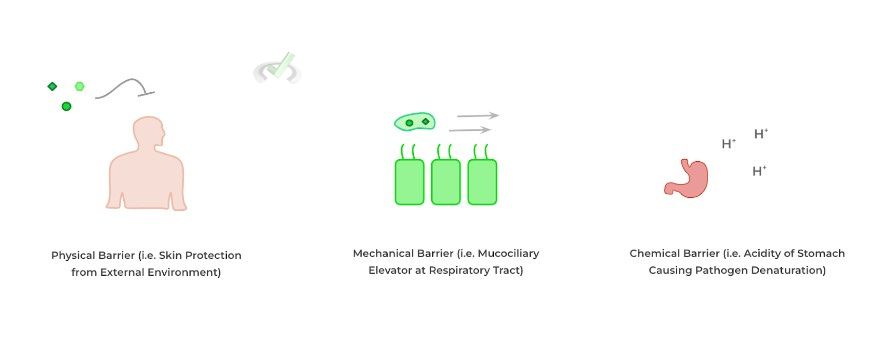
As the name implies, physical innate defenses rely on physical barriers to prevent infection from entering into our system in the first place — look no further than your glowing skin around the body which separates our internal environment from the external world!
Additionally, our respiratory tract is lined with cells with motile cilia facing the lumen — via the additional secretion of mucus which can trap incoming pathogens, the cilia then “beat” to allow for mechanical movement of those trapped particles up from the throat to be coughed out! Finally, think of the high acidity of gastric secretions which can chemically breakdown pathogens which have been ingested.
We won’t go into too much detail in regards to the innate immune cells and their function as we have a whole specialized article for that; however, the main important thing to know collectively about these cells is that they lack the ability to establish immunological memory.
The presence of an immunological memory for an infection means that a more rapid immune response can be generated to eliminate an infection which has occurred previously — this requires the recognition of a SPECIFIC antigen and because innate immune cells only recognize a broad range of antigens, an immunological memory can’t be established.
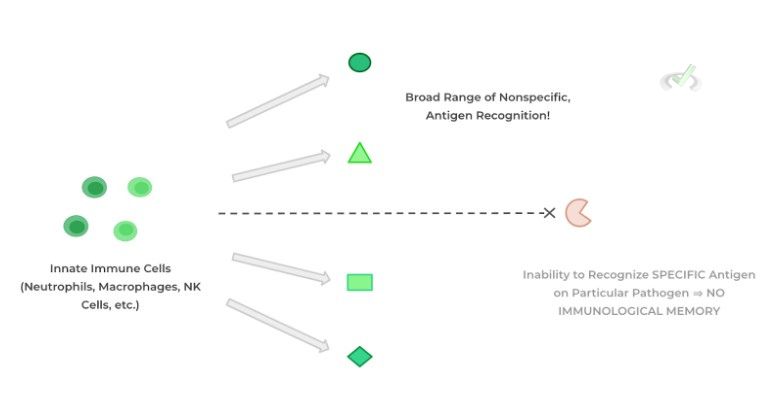
Because adaptive immune cells do have the ability to recognize specific antigens that are unique to a particular pathogen, they can establish immunological memory as we’ll discuss in further detail in the upcoming paragraphs.
B. Adaptive Immune System
As the name implies, the adaptive immune system is the subdivision of the immune system which can adapt its immune response in the sense that it can establish an immunological memory to an infection which has occurred previously.
The establishment of this immunological memory is accomplished by a process called clonal selection. Clonal selection refers to how a pathogen’s specific, unique antigen is recognized by only one type of B and T cell lymphocytes via a specific antigen recognizing receptor (T and B cell receptors) — these are the main cells of the adaptive immune system which we’ll talk more about.
Once the T and B cells which have receptors which are specific for the unique antigen have been selected, they are stimulated to proliferate so that they can be released into the bloodstream and migrate to the site of infection in order to effectively eliminate the pathogen.
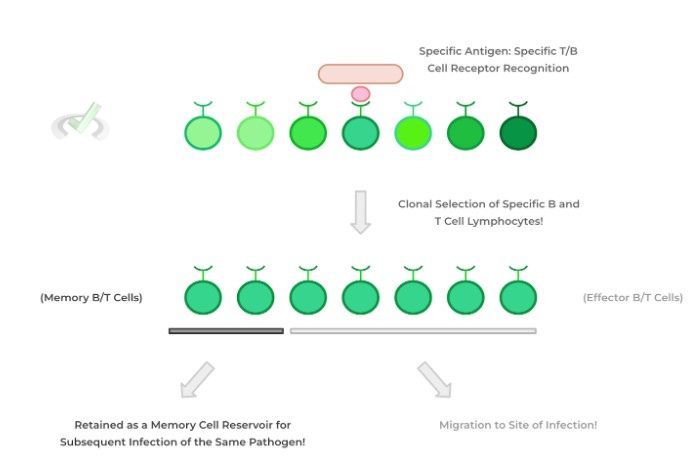
Because it takes time to select the T and B cell lymphocytes with the specific receptors for that particular pathogenic antigen, the adaptive immune response is generally much slower and longer in duration, often taking a couple days before mounting an immune response.
With the concept of clonal selection and immunological memory in mind, we can get a better understanding of the concepts of primary (1˚) and secondary (2˚) infection. As the name implies, primary infection refers to the first time an individual encounters a new infection via a pathogen.
It’s during primary infection that the process of clonal selection first takes place and the selection/stimulation of a specific subset of T and B cell lymphocytes can occur. By the end of primary infection, there will be an abundant amount of memory B and T cells with the receptor specific for that pathogen, specifically its antigen.
Secondary infection basically refers to any infection of the same pathogen which has occurred after the primary infection. Because there’s now an abundant amount of memory B and T cells with the specific receptor for that pathogen — which was created via clonal selection in 1˚ infection, the adaptive immune response can be initiated much faster!
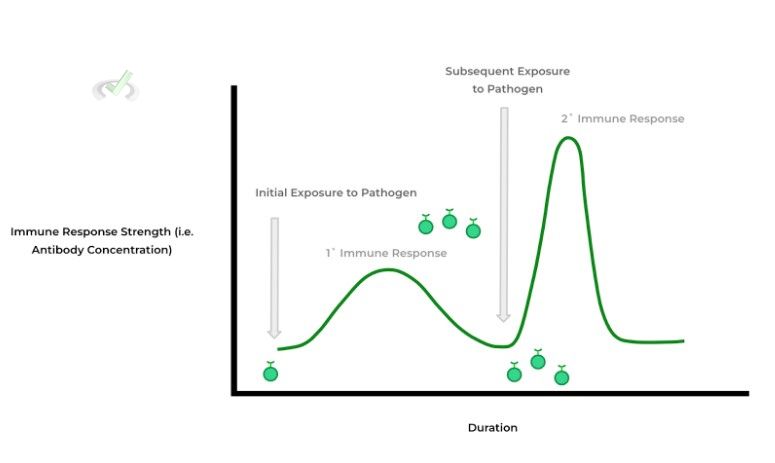
Notice how in the diagram above, the primary immune response takes much longer and has a lower immune response strength because of the time it takes for clonal selection to allow for the expansion of the specific T and B cells.
However in the secondary immune response, there’s been a reservoir of memory T and B cells which allow for a much faster recognition, expansion, and stronger response to eliminate the pathogen as indicated by the higher curve and quicker duration. This increased specificity is also why the adaptive immune system is also stronger than the innate immune system.
Refer now to the diagram below for a side by side comparison of the innate and adaptive immune system!
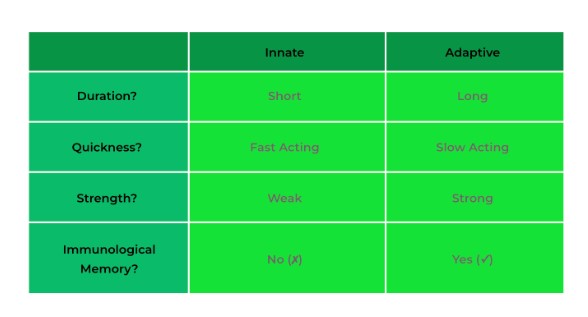
III. Bridge/Overlap
The specificity of the B and T cell receptors towards specific antigens for pathogens is garnered by the various binding interactions which take place between the receptor and antigen. Let’s go ahead and review some of these main binding interactions and how they allow for antigen recognition.
I. Intermolecular Forces Between Amino Acids
Receptors and antigens are essentially just proteins with various combinations of amino acids — generally speaking, the strength of binding of an antigen by the receptor binding site is dictated by how strong the intermolecular interactions are between the amino acids located within the receptor binding site and the specific part of the antigen (i.e the epitope).
The intermolecular forces that play a main role in antigen-receptor recognition are those in conventional general chemistry: electrostatic (cation-anion) interactions, hydrogen bonding, dipole-dipole interactions, and hydrophobic interactions as shown below.
IV. Wrap Up/Key Terms
Let’s take this time to wrap up & concisely summarize what we covered above in the article!
A. Innate Immune System
The innate immune system is the subdivision of your immune system which is your body’s first line defense — it consists of cells and barriers which quickly act to prevent or suppress infection as it’s the portion of the immune system which is always primed and activated immediately.
Aside from the innate immune cells, the innate immune system also consists of various strategies which can help prevent infection which can be divided into physical barriers (such as the skin), mechanical barriers (such as the mucociliary elevator within the respiratory tract), and chemical barriers (i.e. the increased acidity of gastric acid secretions).
Though fast acting, the innate immune system DOES NOT have the ability to generate an immunological memory because it only recognizes a broad range of antigens — in order to generate an immune response, a specific antigen that’s recognized by a specific receptor can only generate an immune response as seen in the adaptive immune system.
B. Adaptive Immune System
The adaptive immune system is your slower, but stronger and more specific immune response due to the fact that it requires a specific selection of B and T cell lymphocytes which have receptors specific for particular antigen of pathogen — this process is called clonal selection.
Clonal selection also provides the basis for the differences in the primary (1˚) and secondary (2˚) immune response! The primary immune response refers to the immune response generated by the initial exposure of a pathogen (and its antigen) to an individual.
The secondary immune response refers to the subsequent immune responses that occur with subsequent infections of the same pathogens. The secondary immune response is much faster to generate and is stronger due to the reservoir of memory B and T cells which are present from the primary immune response!
V. Practice
Take a look at these practice questions to see and solidify your understanding!
Sample Practice Question 1
Toll-like receptors are receptors present on both immune cells and parenchymal cells which recognize molecules present on a wide variety of pathogens and microorganisms. As such, which subdivision of the immune system are toll-like receptors most likely to be involved in and why?
A. Innate Immune System, Broad Antigen Recognition
B. Innate Immune System, Pathogen Specific Antigen Recognition
C. Adaptive Immune System, Broad Antigen Recognition
D. Adaptive Immune System, Pathogen Specific Antigen Recognition
Ans. A
Recall that the innate immune system is generally weaker compared to the adaptive immune system because it recognizes a broad range of antigens. Because TLRs recognize molecules present on a wide variety of pathogens, it probably also means they recognize a wide variety of antigens.
Sample Practice Question 2
Severe combined immunodeficiency (SCID) syndrome is a genetic disease which prevents the maturation and expression of B and T cell receptors. As such, which immune response would be affected?
A. Primary Immune Response
B. Secondary Immune Response
C. Both
D. Neither
Ans. C
Because no T and B cell receptors can be produced, there will be no primary immune response formed because there won’t be any antigen recognition by the T and B cells due to lack of receptor expression. Because of this, the secondary immune response will also subsequently be affected.


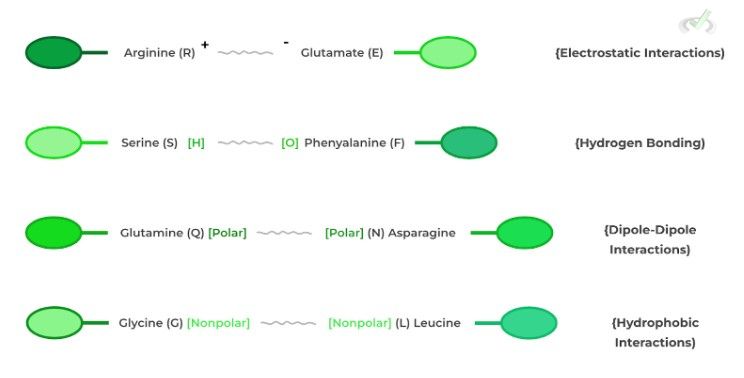





 To help you achieve your goal MCAT score, we take turns hosting these
To help you achieve your goal MCAT score, we take turns hosting these 





















 reviews on TrustPilot
reviews on TrustPilot